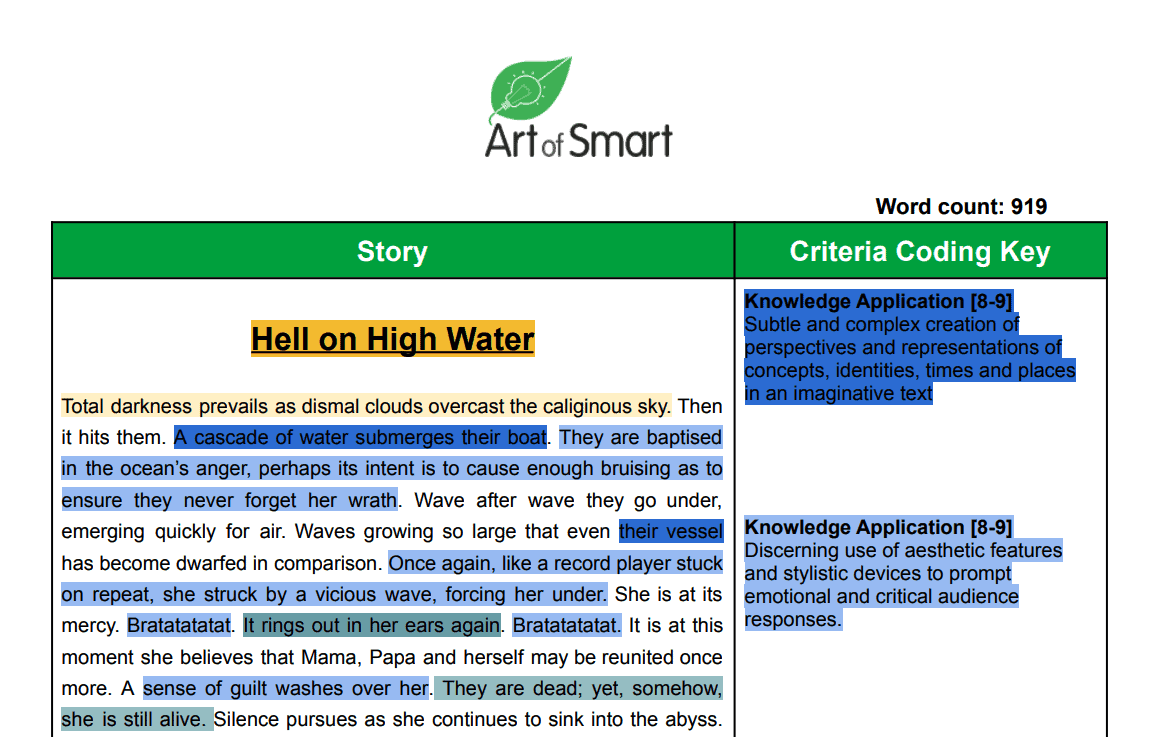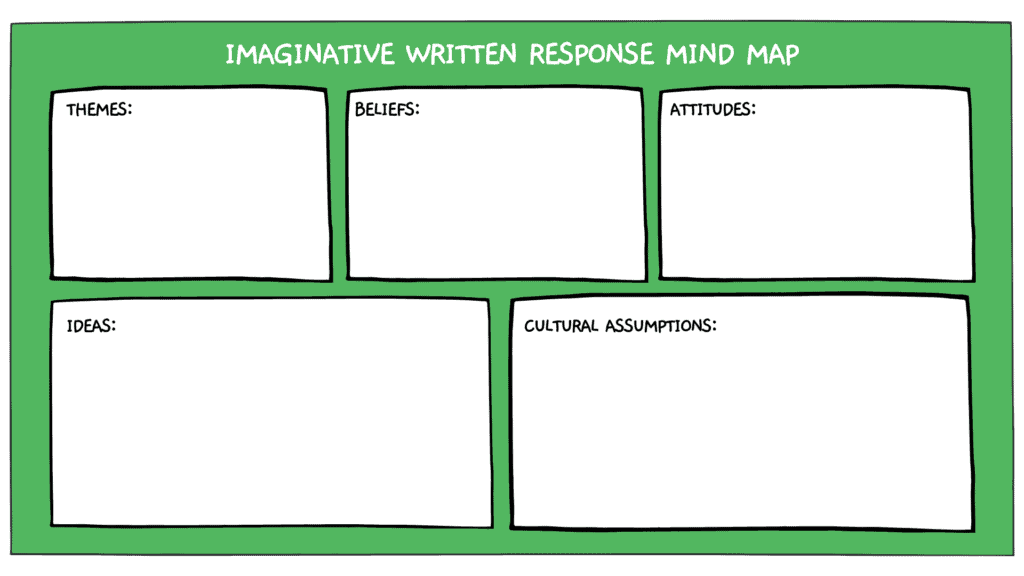Just received your assessment notification to complete an Imaginative Written Response for QCAA English and aren’t sure how to get started?
Don’t worry, we’re here to help! We’ll guide you through the requirements, a simple structure you can follow to write your piece up, and some tips to help you craft an awesome response.
We’ve even got a sample annotated Imaginative Written Response that you can download!
Ready to tackle this English assessment? Let’s get started!
What is an Imaginative Written Response?
How to Structure Your Imaginative Written Response
General Tips
What is an Imaginative Written Response?
This task requires you to interpret a poem (selected from the prescribed text list — which can be accessed here) in order to use it as a springboard for a short story of your creation!
You will have 800-1000 words to experiment with different textual and language features to conjure up an imaginative response that draws on perspectives, concepts, identities, times or places represented in a single poem.
It is vital that your story draws on the ideas, values, attitudes or beliefs underpinned within the original poem. In order to successfully complete this task, you are required to:
- Select an aspect/s of the poem to inspire your story (i.e. an idea or perspective presented in the poem)
- Decide how you will use language conventions and literary devices to prompt an emotional and/or critical response from the reader (i.e. experimenting with structure or perspective)
According to the QCAA, you will be assessed on your ability to:
- Employ different patterns and conventions of the imaginative genre to achieve a particular goal
- Generate perspectives and representations of concepts, identities, times and places in a creative text
- Invite readers to support a position via exploring the cultural assumptions, attitudes, beliefs and values emphasised within the poem
- Purposefully use a variety of aesthetic features and stylistic devices
- Effectively organise and sequence subject matter
- Make appropriate language and grammar choices
How to Structure Your Imaginative Written Response
For this task, there is no set structure you must follow and you have full creative freedom to explore different structures and experiment. If creative writing is right up your alley, then I encourage you to have fun with this!
However, if this task is particularly daunting for you, then you can’t go wrong with using the standard structure for an imaginative piece.
The structure of the assignment will be judged by the following criteria:
- Discerning use of the patterns and conventions of an imaginative text and the role of the writer to achieve particular purposes and relationships with audiences
- Discerning selection and synthesis of subject matter to support perspectives
- Discerning organisation and sequencing of subject matter to achieve particular purposes, including discerning use of cohesive devices to emphasise ideas and connect parts of an imaginative text
The most popular way to structure a short story is the three-act structure:
Act 1: The Setup
In Act 1, your goal is to introduce your characters and establish a setting and tone. However, it is also important to remember that every good story needs a good hook to lure in the readers!
To ensure your readers are enticed, you should introduce the main character and attempt to have the reader either connect to the character or feel emotionally invested in the character (you can do this by recalling the character’s past and/or by nodding to the story’s inciting incident that leads to the conflict faced by the protagonist).
For the character introduction, it’s important that you show the readers the character’s life, rather than tell the readers. This ensures that the story is more engaging as it feels less like a lecture.
Further, this allows you to represent the world through the tone and voice of your character — allowing for the audience to better connect with them!
The inciting incident must be a moment that changes the entire course of the protagonist’s life. It’s important that this event is exciting (or demands some emotional response) and necessitates the sustained attention of the audience.
Act 2: The Confrontation
Your goal is to keep the reader interested as you develop the plot-line in preparation for the climax.
In this part of the story, your character/s should face some complications — allowing for the climax to develop.
It’s important to keep the readers engaged. This can be achieved by throwing them, and the protagonist, out of their comfort zones.
Ideally, your characters, plot, and any cultural assumptions, ideas or beliefs, should tie into the story’s major conflict. In doing so, you will create cohesion amongst each of the individual components of the story!
Act 3: The Resolution
The reader should encounter the lead up to the climax, the climax itself, and the resolution.
In this act, the main character attempts to tip the balance between triumph and defeat as they face trials and tribulations and solve problems.
The lead up to the climax should increase the tension felt by the reader, the climax itself should be the biggest hurdle faced by the protagonist (this component should also include any major plot twists), and the resolution is where you tie up any loose ends and answer any questions that, thus far, remain unanswered.
General Tips
With this task, you are given one week to prepare before the exam. If you don’t feel very confident with creative writing, you can still prepare a story beforehand that you can adapt when you sit the assessment.
Below are a few general tips for writing a short story and preparing for the exam!
Tip #1: Use a mind map to analyse the poem
Come up with a mind map beforehand of different themes, beliefs, attitudes, ideas, cultural assumptions from the original poem that you would like to include in your story.
Attempt to link these to components of the story such as the setting and plot. Each detail within the story should contribute to the greater meaning or the end goal!
You might want to create a mind map similar to the one below:
Tip #2: Develop your protagonist before you start writing
Questions you should ask yourself as you create your main character are:
- Who are they?
- What is their back story?
- What are their values, ideas or beliefs?
Being able to answer these questions is important as they’ll guide the decisions your character makes throughout the story.
Tip #3: Jump straight into the deep end
At the beginning of the story jump straight into the deep end! Don’t worry too much about explaining every little detail of the plot to your reader — let the important details shine through in the protagonist’s experiences.
Tip #4: Make sure the setting is specific
Your setting will lay the foundations of your story, so it’s essential to make it specific and interesting. It should also link to the themes, beliefs, attitudes, ideas or cultural assumptions of the original poem.
Tip #5: Be intentional about the aspects you include in your story
Don’t include too many conflicts as this can be messy and difficult to resolve, and you only have so many words to write during the exam.
Additionally, you should be purposeful with your language and avoid weak and boring words — but, also refrain from thesaurus-ing every second word!
Marking Criteria
You will be judged on your ability to:
- Use subtle and complex means to create perspectives and representations of concepts, identities, times and places in an imaginative text
- Discerningly manipulate the ways cultural assumptions, attitudes, values and beliefs underpin texts and invite audiences to take up positions
- Discerningly use aesthetic features and stylistic devices to prompt emotional and critical audience responses
- Make discerning language choices for a particular purpose
- Discerningly combine a range of grammatically accurate/appropriate language structures, including clauses and sentences to achieve particular purposes
- Discerningly use written features, including conventional spelling and punctuation, to achieve particular purposes
Following the aforementioned tips will help you to successfully hit this criteria! Good luck!
Once you’ve received your marks back from this task, you should see how you’re tracking with our QCE Cohort Comparison Tool!
On the hunt for other QCAA English resources?
Check out our guides below to help you ace your QCAA English assessments:
- The Ultimate Content Guide for Term 3 of the QCE
- The Complete Guide to Writing an Analytical Essay for QCAA English
- How to Write an Analytical Written Response for Your QCAA English Exam
- How to Create a Written Response for a Public Audience for QCAA English
- How to Craft a Persuasive Spoken Response for QCAA English and Ace Your Assessment!
- How to Ace Your External Assessment for QCAA General English
- Practice Questions for the End of Year English External Exam
Are you looking for some extra support with the Imaginative Written Response?
We have an incredible team of QLD tutors and mentors!
We can help you master the QCAA English syllabus and ace your upcoming English assessments with personalised lessons conducted one-on-one in your home or online!
We have expert English tutors and coaches local to the Brisbane area!
We’ve supported over 8,000 students over the last 11 years, and on average our students score mark improvements of over 20%!
To find out more and get started with an inspirational QLD tutor and mentor, get in touch today or give us a ring on 1300 267 888!
Katelyn Smith was a pioneer in the Queensland ATAR system. After graduating in 2020 with an ATAR of 98.40, she now studies a Bachelor of Advanced Science (Honours) at The University of Queensland — majoring in Physics. Through her studies, she hopes to develop a greater appreciation for how the wonders of the universe work. When she isn’t slaving away behind her unnecessarily large textbooks, she enjoys catching up with friends, scrolling mindlessly through TikTok, and sleeping.







